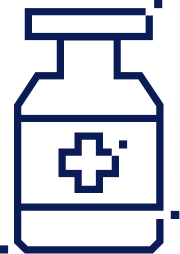
Vaccines
Vaccines Play a Critical Role in Helping Prevent Some of the Most Dangerous Illnesses
Over the last 30 years in the U.S., childhood vaccines have prevented more than one million early deaths and saved $2.7 trillion. From saving lives to promoting healthy aging, vaccines play an important role in building a healthier future for Americans.
Different vaccines offer varying types of protection depending on the disease
Not all vaccines work the same, but they all serve a common purpose: to protect against infections. Vaccines train the immune system to recognize and respond to harmful pathogens before they make people sick. Some vaccines prevent individuals from contracting or transmitting a specific disease, while others decrease the severity and impact of a disease.
Vaccines have delivered some of the greatest health victories in history
Vaccines have reduced the severity and toll of many diseases.

Vaccines Help Leave Serious Diseases in the Past

Diseases |

Annual Morbidity(20th Century) |

Reported Cases(2024) |

Percent Decrease |
|---|---|---|---|
|
Diphtheria |
21,053 |
1 |
99% |
|
Smallpox |
29,005 |
0 |
100% |
|
Measles |
530,217 |
266 |
> 99% |
|
Mumps |
162,344 |
358 |
> 99% |
|
Rubella |
47,745 |
9 |
> 99% |
|
Polio |
16,316 |
0 |
100% |
|
Tetanus |
580 |
32 |
94% |
U.S. leadership in vaccine innovation benefits Americans
We talk about how we have a health care system—in many ways, we have a sickness system. We really need to shift the focus to what we can do to prevent disease and also modulate disease to help people live healthier, longer lives."
Dr. Len Friedland
Vice President and Director of Scientific Affairs and Public Health at GSK

Developing a new vaccine is a lengthy, challenging and expensive process, largely driven by the biopharmaceutical industry
New vaccine development requires large-scale clinical trials, and total development costs can exceed $1 billion.
The Vaccine Lifecycle
Vaccines undergo years of rigorous clinical trials with thousands of volunteers to ensure safety and effectiveness. Once approved, biopharmaceutical companies, FDA and CDC continuously monitor their safety and effectiveness.

The Innovation Ecosystem
For Americans to benefit from vaccination, we need to continue to support robust, safe and effective vaccines.
Our Work in Action
To maintain America’s global leadership, we need to support the next generation of innovation in medicine.












